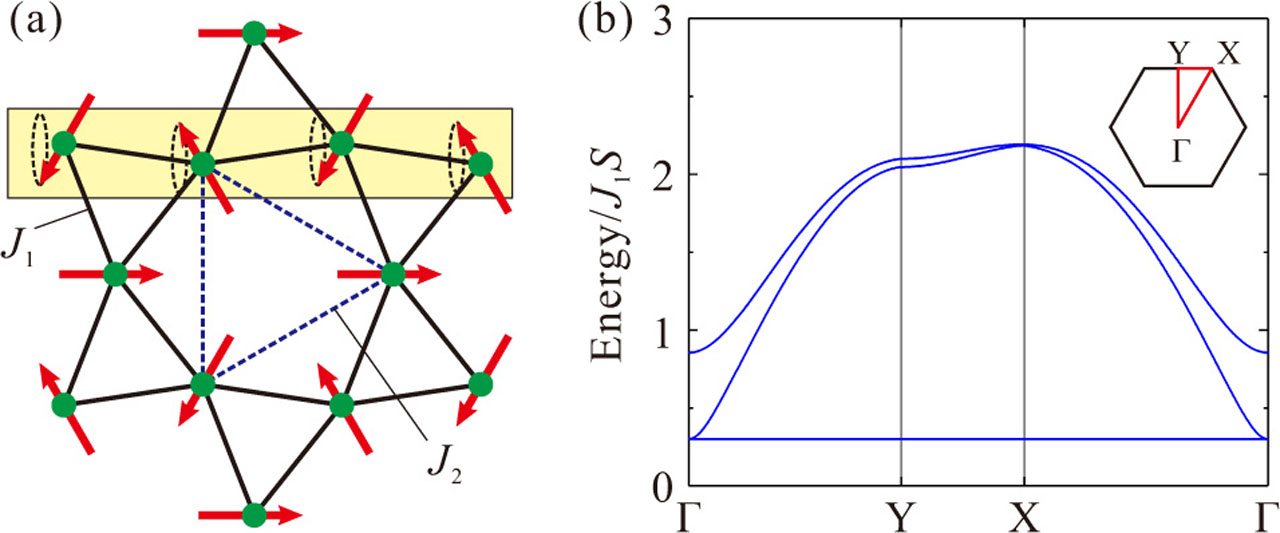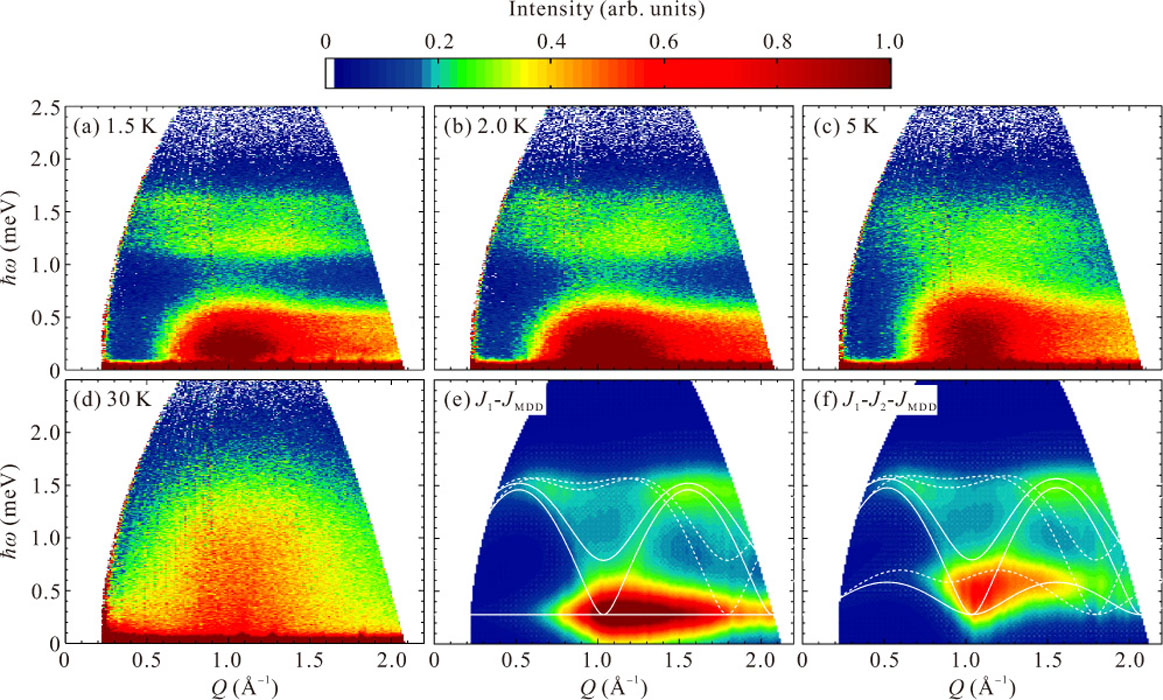Zero-Energy Excitation in the Classical Kagome Antiferromagnet NaBa2Mn3F11
Masuda Group
Localization of spin-wave excitations, so-called zero-energy mode, is one of the unique phenomena in geometrically frustrated magnets [1]. Largely degenerate ground states allow a continuous rearrangement of spins with no energy cost, generating a dispersionless mode in a spin-wave excitation spectrum. The classical kagome antiferromagnet is a prototypical model for the dispersionless mode in the spin-wave excitations. It has an infinite degeneracy of 120° structures in the ground state. This degeneracy allows a continuous change of the spin arrangement with no energy cost, as illustrated in Fig. 1(a).

Fig. 1. (a) Magnetic structure having k = 0 of NaBa2Mn3F11. The red arrows represent directions of spins. Dashed loops illustrate the zero-energy mode as described in the text. Solid and dashed lines are the nearest-neighbor and second-neighbor paths, respectively. (b) Spin-wave excitation having the nearest-neighbor exchange interaction J1 and magnetic dipole-dipole interaction JMDD = J1/100. The energy is normalized by the magnitude of J1 and spin S.
In real kagome antiferromagnets, the macroscopic degeneracy of the 120° structures is solved by some types of magnetic anisotropy such as the Dzyaloshinskii-Moriya interaction, single-ion anisotropy, and magnetic dipole-dipole interaction. Then, the zero-energy mode becomes visible as an excited state lifted by those anisotropies. Although the zero-energy mode is one of the most characteristic phenomena in frustrated kagome antiferromagnets, it has been reported only in KFe3(OH)6(SO4)2 [2]. Therefore, further study in different materials is highly desirable.
Our target material, a classical kagome antiferromagnet NaBa2Mn3F11 [3], is a promising candidate exhibiting the zero-energy mode. Mn2+ ions having spin S = 5/2 are responsible for magnetic properties. Neutron powder diffraction demonstrated that antiferromagnetic order below TN = 2 K forms the 120° structure selected by the magnetic dipolar interaction [4], as shown in Fig. 1(a). According to theoretical studies, the zero-energy mode in the classical kagome antiferromagnet with the magnetic dipolar interaction is predicted to emerge at its lowest excited state [5], as shown in Fig. 1(b). Hereby, we report the zero-energy mode excitation in NaBa2Mn3F11 through a combination of inelastic neutron scattering technique and linear spin-wave calculations [6].
Figures 2(a)-2(d) show a temperature variation of the inelastic neutron scattering spectra for a powder sample of NaBa2Mn3F11. Magnetic diffuse scattering indicative of short-range correlation is observed at 30 K in the paramagnetic phase [Fig. 2(d)]. The diffuse scattering is suppressed with decreasing temperature, and the spectrum splits into two parts: strong intensity at 0.2 meV and weak intensity at 1.5 meV [Figs. 2(a)-2(c)]. In the magnetic ordered state at 1.5 K, spin-wave excitations having a magnetic anisotropy gap of 0.21 meV is observed, as shown in Fig. 2(a). Notably, the excitation at 0.21 meV does not shift on varying wave number Q. This suggests that the excitation is a dispersionless zero-energy mode lifted by the magnetic dipolar interaction.

Fig. 2. Inelastic neutron scattering spectra of NaBa2Mn3F11 at (a) 1.5 K, (b) 2.0 K, (c) 5 K and (d) 30 K. The incident neutron energy is Ei = 3.1 meV. Calculated spin-wave spectra with (e) J1 = 0.28 meV, J2 = 0, and JMDD = 4.9 μeV and with (f) J1 = 0.27 meV, J2 = J1/10, and JMDD = 4.9 μeV. Solid and dashed curves in (e) and (f) are spin-wave dispersions along [1 0 0] and [1 1 0] directions, respectively.
To identify if the observed dispersionless mode indeed originate from the magnetic dipolar interaction, we simulated the spin-wave excitation spectra in the linear spin-wave theory with considering the nearest-neighbor exchange interaction J1, the second neighbor exchange interaction J2, and the nearest-neighbor magnetic dipolar interactions JMDD. Figures 2(e) and 2(f) show powder-averaged spin-wave spectra in J1-JMDD and J1-J2-JMDD models, respectively. The calculated spectra semi-qualitatively reproduce the low-energy strong excitation and high-energy weak excitation. Importantly, the calculated spectrum shows that the second-neighbor interaction J2 makes the zero-energy excitation dispersive (Fig. 2(f)), because further neighboring interactions suppress the continuous rearrangement of the spins with no energy cost. This means that the observed dispersionless excitation at 0.2 meV indicates that J2 is negligible in NaBa2Mn3F11.
The most remarkable finding is that the energy position of the dispersionless mode is reproduced solely by the magnetic dipolar interaction. We note that the magnetic dipolar interaction is ubiquitous in every real magnet even though the qualitative behavior of most kagome antiferromagnet can be explained by models including only the nearest-neighbor interaction. Therefore, we come to the conclusion that the observed dispersionless excitation in NaBa2Mn3F11 is the ideal zero-energy mode in the realistic classical kagome antiferromagnet.
In summary, we discovered a dispersionless zero energy mode in the classical kagome antiferromagnet NaBa2Mn3F11 by the inelastic neutron scattering technique. The calculations based on the linear spin-wave theory reveal that the excitation is described by the zero-energy mode lifted solely by the magnetic dipole-dipole interactions. NaBa2Mn3F11 is a unique classical kagome antiferromagnet exhibiting a truly dispersionless lifted zero-energy excitation.
References
- [1] A. B. Harris, C. Kallin, and A. J. Berlinsky, Phys. Rev. B 45, 2899 (1992).
- [2] K. Matan et al., Phys. Rev. Lett. 96, 247201 (2006).
- [3] H. Ishikawa et al., J. Phys. Soc. Jpn. 83, 043703 (2014).
- [4] S. Hayashida et al., Phys. Rev. B 97, 054411 (2018).
- [5] M. Maksymenko, R. Moessner, and K. Shtengel, Phys. Rev. B 96, 134411 (2017).
- [6] S. Hayashida, H. Ishikawa, Y. Okamoto, T. Okubo, Z. Hiroi, G. J. Nilsen, H. Mutka, and T. Masuda, Phys. Rev. B 101, 214409 (2020).
